Serviços Personalizados
Journal
Artigo
Indicadores
-
 Citado por SciELO
Citado por SciELO -
 Acessos
Acessos
Links relacionados
-
 Similares em
SciELO
Similares em
SciELO
Compartilhar
CIDADES, Comunidades e Territórios
versão On-line ISSN 2182-3030
CIDADES no.31 Lisboa dez. 2015
https://doi.org/10.15847/citiescommunitiesterritories.dec2015.031.art03
ARTIGO ORIGINAL
Are the Streets Still for Dreaming? Punk, Thrash, and Heavy Metal: An Unrecorded Blueprint of Beirut"s Urban Landscape.
As Ruas Ainda São para Sonhar? Punk, Thrash e Heavy Metal: Uma planta não registada da paisagem urbana de Beirute.
Lynn OsmanI
[I]ALBA – Academie Libanaise des Beaux Arts, Lebanon. e-mail: gdlynnosman@yahoo.fr.
ABSTRACT
The sphere of skateboarding, Metal, Thrash and Punk rock, interweaved into a self-differentiated, around a decade-old music and DIY underground culture, unfolds into an urban experience and proposes another perspective on the limits of historically framing "Punk subculture". The lifestyle and variable factorial structure of the group defines the shifting identity boundaries of the sphere, where thrashing and music share rituals and practices, and redefine the urban experience on two levels: remapping the city"s axis through thrashing the streets, and the underground and DIY music practices. From the urban fabric, layered and divided with sects, political affiliations, and socio-economic classes, the group of a young and charged history sparks with an assault with a gesture, from the shapeless, as an autonomous act of a time-space capsule that escapes and disrupts preexisting social boundaries and patterns, through a "poetic" relationship to space. From the sphere of voices, with an alternating rhythm of punctual cuts through the urban layers of identity, an unspoken narrative starts to form, where a new layer, with a mayhem resistance, breaches identity constructs and loaded places. But the rhythm lead the narrative to shape itself as a linear one. Therefore, questions about continuity have surfaced, due to the scene having a differentiated genesis and structure. The sphere has rooted geo-specific practices transmitting, appropriating and constructing a "displaced" musical heritage anchored in its own history, becoming an auto-referential non-place. Permeable to global mainstream, while resisting the postmodern aesthetics" assimilation the ephemeral "Other", the sphere resists sociological objectification and representation models, accepting no discourse, even that of a subculture, but, in spite, becomes a social agent. If the production of music and space has become a fulfilled or broken promise for itself and for its reception, although a viable and valuable mode to revitalize the study of sociological frameworks, how would sociological objectification then be escaped?
Keywords: Underground music, identity boundaries, sociological objectification, urban layers, Beirut..
Re-framing Punk Subculture in Beirut"s Urban Context
The research departs from my initial framework of questioning the historical limits of labeling "Punk subculture" and the possibility of an ahistorical projection of the subculture"s layers bound to the initial historical sociological context of coining the term "Punk".
The seeds of subculture formation spread into distant grounds, historically, sociologically and geographically, where different subcultures that had anticipated or followed Punk subculture, although claimed "dead", have been carried by a shared gravity and energy, and have held different forms to manifest themselves, or shared a common iconography or iconographic gestures.
The sphere of skateboarding, Metal, Thrash, and Punk rock, interweaved into about a decade-old music and DIY underground culture, and self-differentiated from the larger Metal scene in Lebanon that had started in the post-war era of the 1990"s.
The interaction of skateboarding, gigs, events, narratives, incidents, and oral history, formed a tangent perspective to the city, from within and without the sphere, a point of departure spinning the urban experience, breaching the preexisting urban visualization. Within and on a threshold, alternately, we witnessed what could be a turning point to the scene.
In Beirut, the cultural identification to "Punk" is inverted, where the preexistent cultural codes and practices are partially raised from the dead, appropriated and recreated, and sparked on a deferred stage in a hybrid space-time capsule through a differentiated exposure, meanings and means of circulation, into ties of belonging and another anticipated vision, a local scene, social and urban spaces connected to thrashing, Heavy Metal, Punk rock, lifestyle and an urban experience diverging locally as well as regionally from the Middle Eastern underground scene.
The paper aims to unfold a narrative of the sphere at a junction where an unspoken narrative of the scene is forming, and reaching alternately a linearity of structure. The paper unfolds from an experiential perspective, a poetic relationship to space, place and music, to suggest how the body, sound and voices rewrite places into an unrecorded blueprint, and produce a self-referential narrative that dislocates urban constructs at an altering rhythm, becoming a carrier of social agents, in spite.
Still illegitimate objects of study with an undeclared narrative, the scene's acts are a fulfilled or a broken promise for themselves and for their reception, yet a viable and valuable mode to revitalize the study of social frameworks. The question is then how sociological objectification can be escaped for such a group that disrupts sociological frameworks?
Out of Timeframe, A DIY Scene: A Brief History of the Formation and Unfolding the Scene
During the post-civil war era of the 1990s, the Metal scene in Lebanon has arisen. Thomas Burkhalter traces accounts of the Metal scene in the chapter "Metal Music and Classic Rock" of his book Local Music Scenes and Globalization: Transnational Platforms in Beirut. Weeping Willow (Death Metal) and Blaakyum have been active since that period. The bands were mostly underground, when few gained exposure throughout from provocation, censorship or venues (Burkhalter, 2013: 43). There are accounts of some Metal bands from the civil war era of the 1980s, but no other evident traces are found nowadays from the production of that era.
Around 2006 (year of the July war) until 2008, concert venues, mainly the pubs Nova, Cherry's, and La Cite Jounieh, accommodated the scene. Within the broader Metal scene that is ethnically and geographically differentiated (Hamra, Armenian district, and further cities in Lebanon), a concert venue, hangout and jamming place was founded in "Pavillon" center in Hamra, where the Metal sphere was forcefully consolidated with bands such as the Gamblers, Damaar, and Nightchains (2003-2006, Speed and Power Metal band). It was the key Metal venue where a differentiated scene was formed. After the closing of the venue, the majority of the group relocated back again to the streets, mainly to the alley of the same Hamra area. In parallel, a group of skateboarders was thrashing the streets, as well as skateboarding in Beirut"s Central District, the post-war restored and privatized area, whether in the parking lots or practicing around Martyrs" Square"s statue, a historical landmark, to the proximity of roller skaters and BMXers. The parking lot became a construction site and the skaters moved again.
Few skaters started to thrash the streets as teenagers, Kamikaze 3 (K3). Skateboarding grew as a group, then into careers, a shop (whereas they use to import material), events and pop-up parks, an association and sponsorships. "They were good at something only (staring as three in Beirut) were doing. They didn"t want people to like them, really" (Butz, 2011); a group with its own rituals, practices, boundaries and spirit.
The group grew while the underground music scene and skateboarding were intersecting, forming a sphere. While the Pavillon Center"s venue was closing down, other bands were formed. Thrash Storm (Thrash Metal/ Hardcore Punk), formed in 2007 held their gig at La Cite Jounieh. Discharging a powerful spirit, these acts, along with the Pavillon venue gigs, were the golden age of the Metal scene in Beirut as referred to nowadays. Around that period, many musicians and band members from the Metal scene shifted and reversed into Islamic beliefs and lifestyles. This wave influenced the drift, the disbanding and fragmentation of the scene, while other bands appeared or were reformed with new members.
Detox, the Punk band succeeding Benzene, self-proclaimed first Punk band in Lebanon, formed in 2006 (with guitarist Tex -lead of Gamblers and Nightchains, and Aida, vocalist-of Benzene; with bass, double bass, drums, keyboards etc.). The first gig and release were held at American Dream, an old pub adjacent to the old alley, adjusted to the underground scene. Detox"s topics are further socially engaged and involved in rebellion and anarchy, divulge the system, mainstream and corporations, expose other beliefs and echo society's alarms. New topics are approached, distinct from the canonized Metal subjects, while often sharing a common audience with the Metal bands gigs. They held last a gig in Beirut, along Thrash Storm, at Babel Theatre"s underground space in 2012, where slam dance and moshing ruled. Thrash Storm performed as well later in Metal concert events while they held other gigs at American Dream in Hamra, and in 2012 performed for the opening night of the renovated venue; American Dream being a short time-span initiative to consolidate a new place to revitalize the scene.
In 2010, Beirut Scum Society was formed, having Punk and Rockabilly influences. Their gigs were first held underground, and then became adjacent to the alternative music scene.
The hybrid sphere interweaved Metal, Thrash, and Punk bands and skateboarding. Shared rituals, social practices and places crossed over and shaped an underground scene differentiated from the larger Metal scene which had its canons, rules, image, and topics. (Figures 1 through 5)
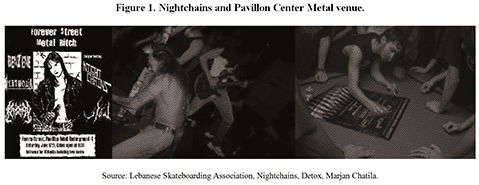
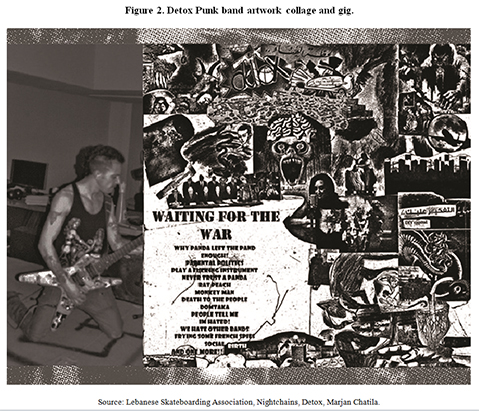
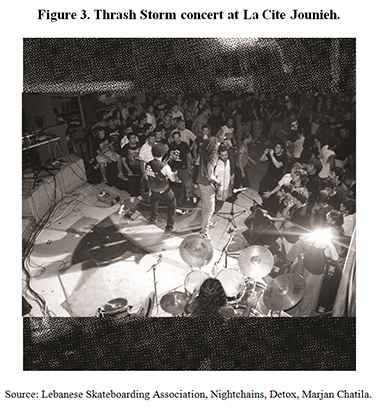
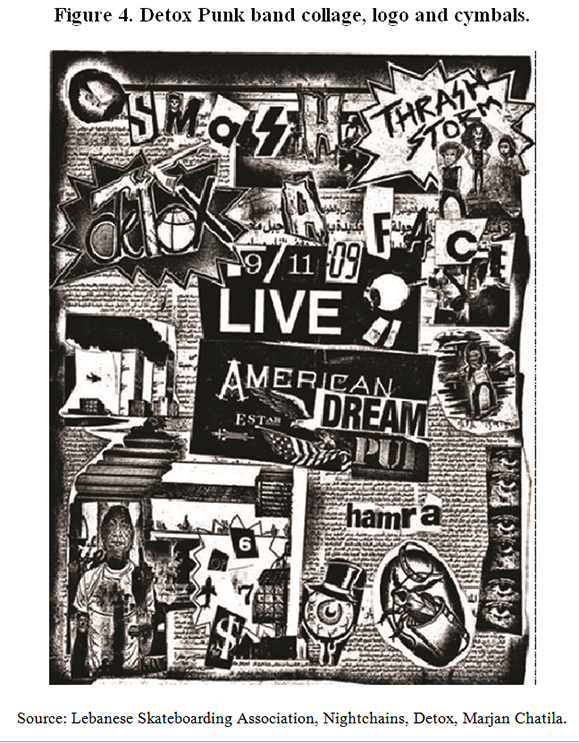
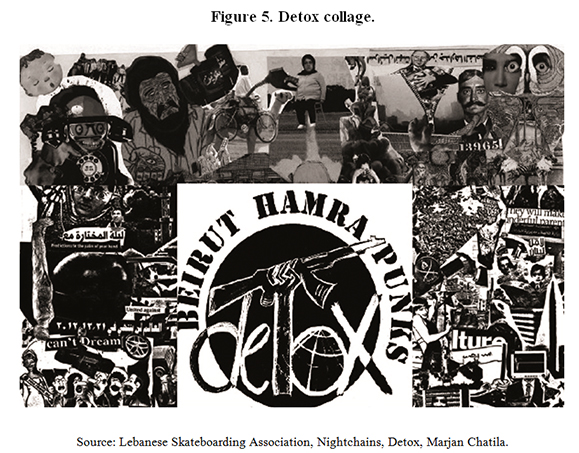
Skateboarding was injected within the city by the K3, diffused and shaped an added a layer to the urban experience, another perspective, spirit and place for fun, destroying and reshaping the urban constructs. Beirut, has a complex and layered urban fabric and shifting boundaries that fluctuate with layers and juxtapositions of clusters of distinct or intersecting sects, socio-economic classes, political affiliations, areas" identifications, and crossings of heritage remains and post-war reconstruction buildings and new residences (Figures 6 & 7)
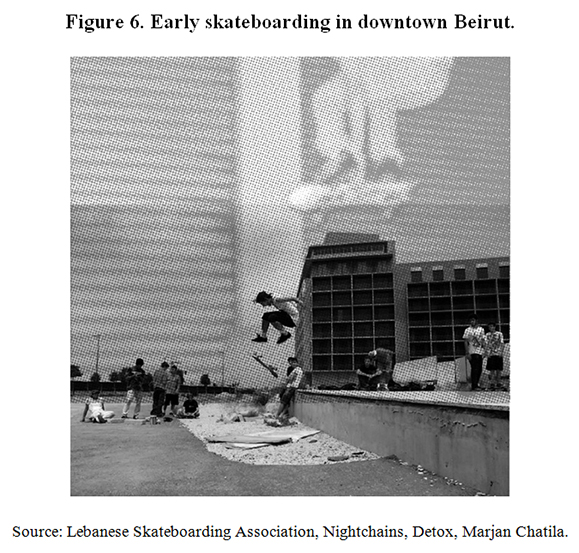
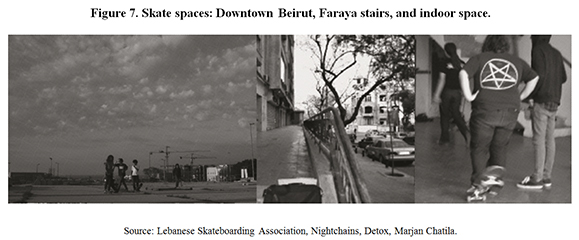
From the urban fabric layered and alienated with sects, political affiliations, and socio-economic classes, the group, resonant with a young and charged history, sparks from the shapeless with an assault from gesture, as an autonomous act of a time-space capsule that escapes and disrupts preexisting social boundaries and patterns.
Lifestyle redefines the urban experience and the shifting identity boundaries, where thrashing and music are associated, which, in turn, redefines the urban experience on two levels: remapping the city through thrashing the streets, and the underground music practices, where Punk rock, Metal, and Thrash share audience, music acts, spaces, and rituals.
Skateboarding, as an injected social event in the city, autonomous and self-referential, defied in an unspoken flow the preexisting norms by redrawing the map of the city through ritual resistance, and by submitting to the city a sphere that has still been unknown, adjacent but yet infrequent, for it was different from the BMX and rollerblading scene, which were more available and integrated.
Redefining the Urban Experience on Two Levels: Remapping the City Axis through Thrashing the Streets and the Underground and DIY Music Practices
Are the Streets Still for Dreaming? A Phenomenological Approach to Place
Skateboarding infers inherently a relationship between the ground and the body. Tricks were surpassed to become moves and lifestyle determining in turn a relationship to place that is essentially "poetic", and latently overriding other preexisting relationships to place. This poetic relationship unfolds the realm of the imaginary in a continuous or intermittent motion. Are the streets still for dreaming? The act itself, wheels arisen, taps upon the loophole amidst the preexisting constructs.
Place is where the relationship of man to earth or soil is the closest, but it can also, for Dardel, refer to the entire world as basis for human existence. Place and man merge; place is part of the identity of the person who derives from it - each human being defines him/herself, his/her environment, and in particular his/her social belonging in relation to place, and individuals give identity, and even more fundamentally existence, to place. This narrow relationship enables the metaphor of roots, and supposes a temporal dimension. Place is set in time; it is memory and time in crystallized form.
Envisaging place in the post-modern context opens up new perspectives. If places are solely the product of relationships - between human beings and the soil, and among humans - and above all the product of an awareness of these relationships - places and non-places do not exist in the absolute. An airport (one of the examples proposed by Augé) may be inhabited; it is a potential non-place the outcome of which is linked to social practices and behaviors. Along the same lines of reasoning, places can be nomadic and /or ephemeral. They only exist by way of interactions; they exist for the duration of an event or a market, or else follow those who take their homes with them. (Tuan, 1974)
The path of a cruise, the identification and re-naming of ritual places, and the vernacular appropriation of fragments of the streets demarcate the identities of places. Through a changing timeframe, the body rewrites an autobiographical narrative inhabited with memory and set into motion, ephemeral or fixed, and draws representational geographies from within the human geography, as a counter-ride to the loaded significance of places. A non-linear, self-referential and unspoken narrative shapes itself, into a non-place impermeable to the outsider and loaded with energy, DIY freedom, imaginary and affects. It generates place within the saturated meanings of places and subverts therefore the charged significance of urban spaces. The imaginary dimension of the poetic relationship to place is moved by a gravity that breaches the "real", the social, cultural, and political constructs of place.
Lifestyle Shifting the Identity Boundaries and the Urban Experience: Ritual Resistance and Practices
Skateboarding manifests itself as an everyday performance, rewrites an autobiography of the recurrent body as subject and as object within the city, in displacement and movement. It unfolds a self-referential and transient unrecorded blueprint of the city.
Urban landmarks and icons, as well as historical and political nodes, are often appropriated for the skateboarding function and ends. Collectively, the sphere becomes an autonomous space-time capsule that disrupts the social boundaries and patterns. The unspoken narrative injected with a new layer of history is formed, with a mayhem resistance to the loaded places. The axis of the city shifts along the thrashers" movement on a loop or on a trajectory with a changing factorial structure, and is constantly rewritten. Lifestyle directs the change, boundaries, rituals and practices, while it submits to and resists the urban alterations of the city, constructing an unreadable blueprint along the ongoing reconstruction and political instability.
Risks, clashes with the local security on skate spots, relocations, careers, the skate park outside the city, pop-up skate parks and events, sponsorships, competitions, the formation the Lebanese Skateboarding Association, and the growing skate education played a role in changing the blueprint along the decade, along with the initiatives to create a continuous platform to consolidate the scene which was formerly created impulsively.
Landmarks and mainstream sights have lost their initial significance and have become implicit icons, recognizable as a shared code among the sphere. Beirut's Central District (BCD) for example, of the eldest landmarks undergoing several wars and reconstructions, is a symbolic "fence". The Martyr"s square statue in BCD was a place where the first tricks were practiced. The national "fence" became the sphere"s most frequented place to build skills and consequently acquired a ritual value. The Phoenicia Intercontinental hotel near the sea front that has a loaded history, and has undergone the civil war and was rebuilt, became the downhill's nomination (the "Phoencia Downhill"). Other instances include political events, such as the car bomb in BCD, the area where many skate spots are usually banned, deemed "private property". After the December 2013 car bomb, skaters rode those stairs and marble ramps on the explosion site. The act symbolically appropriates the place and the event for the physical function and value, almost neutralizing the incident, despite the security guards" attempts to suspend it. "Skaters by their very nature are urban guerillas: they make everyday use of the useless artifacts of the technological burden, and employ the handiwork of the government/corporate structure in a thousand ways that the original architects could never dream of." (Stecyk, 1976) (Figures 8, 9, 10, 11, 12 & 13)
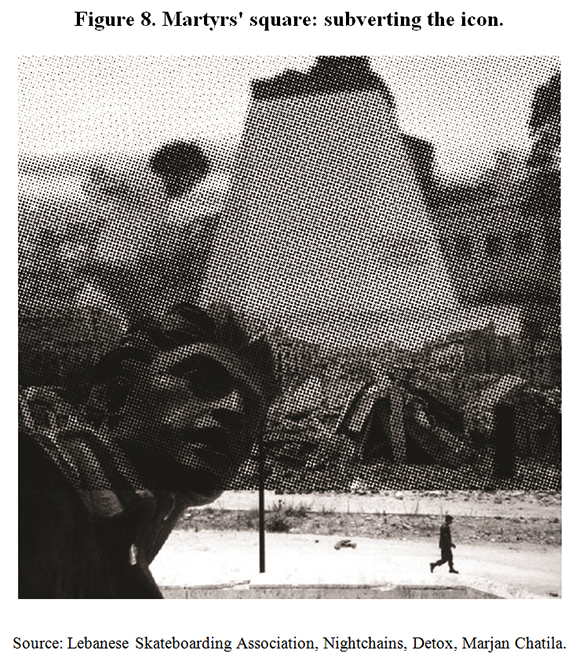
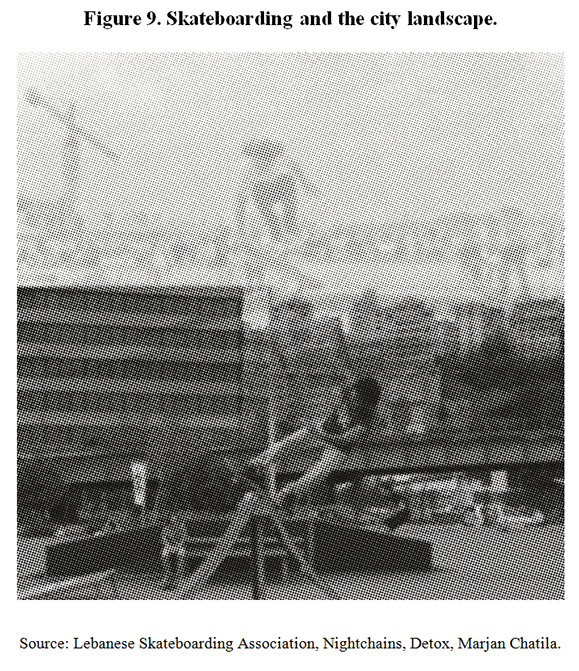
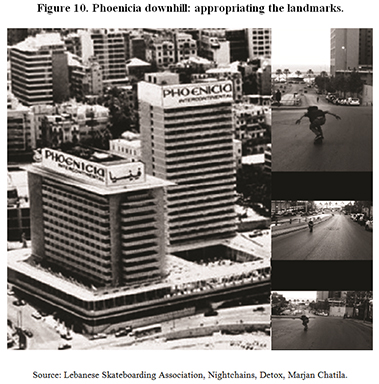
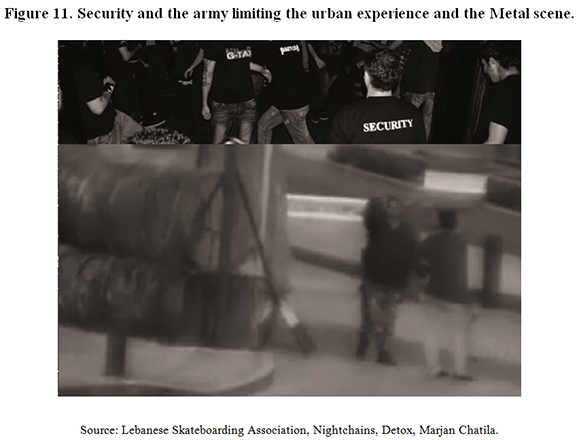
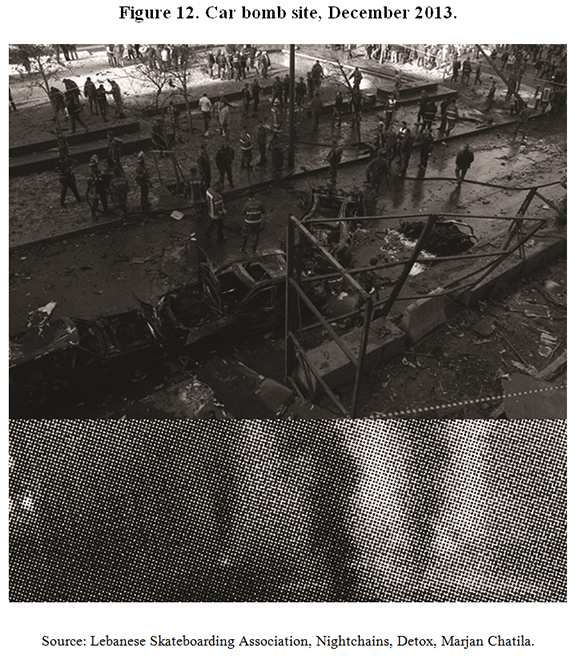
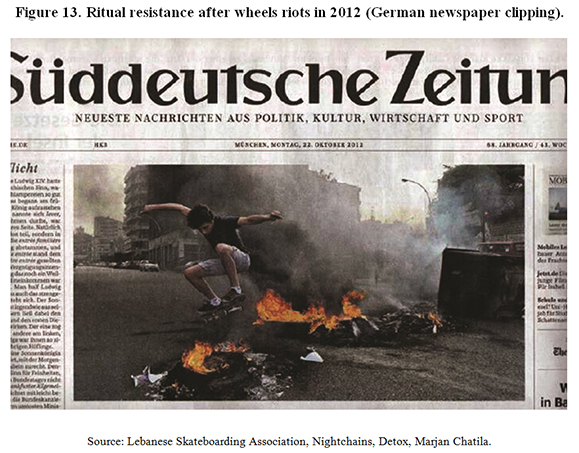
The social and political unrest and alienation induced resistance and catharsis, the reaction of the disobedient youth, as a Punk raw energy was sparking from the underground. Thrashing the streets echoes the city and counters to it, in an almost unilateral dialogue, while being moved by the gravity of the city.
Thrashing the city with roaring wheels is identifiable to its clued listener and draws an imaginary map, reclaiming freedom and territory. It corresponds to a safety pin, stitching fragments into a new urban fabric that is also constantly threatened by its permeability to the city. A specific time-space capsule was formed autonomously. It escapes and disrupts the preexisting social boundaries and patterns. "Safety pin emphasized that things were falling apart. If Britain seemed seriously injured at this time, punk was ready to twist the knife into the wound or, more precisely, mend the void with a rusty pin." (Butz, 2011)
Those instants form the tension cusp of the unspoken non-linear narrative, and are not summoning a reader yet. At an alternating rhythm of punctual cuts through the urban layers of identity, the sphere of voices triggers a new layer of resistance, breaching identity constructs and loaded spaces, producing a public space throughout the individual acts.
A DIY Scene: Bound by Law
Skateboarding seeps into sound; Punk rock, Heavy Metal and Thrash intersect with the skateboarding scene. Both have started as DIY scenes, aggressively, sparking from the unformed, in reaction to one another, and carrying a displaced heritage, but yet heavily anchored in the city. You know what, the energy behind [punk] made perfect sense for skateboarding, adds Olson. Even more than surfing, because skateboarding was a little bit more rowdy –a bit more dangerous. And punk rock had a little bit of danger behind it. There were a lot of similarities happening, but the energy was the most important. The energy behind punk and when you were on your skateboard was extremely raw. [ ] The energy is the connection, the rebelliousness against the typical and against the norm. (Butz, 2011)
From the undercurrent of the skateboarding scene and the Metal scene, Detox and Benzene were the first Punk bands materializing the raw energy into Beirut's underground, along with Heavy Metal, Speed Metal and Thrash bands (such as the Gamblers, Nightchains, Thrash Storm).
Thrash Storm's "Skatanic" mirrors in effect the thrashing drive and resonates with the Thrash Metal features and topics of the band (such as alcohol, evil, hell, war, and Satan).
The scene itself is a DIY scene, built inherently and partially detached from the urban music history. The bands and sonic underground experience were to remap the city through the underground music practices and rituals, de-materializing the urban experience, and restructuring the urban fabric. The underground music production is received by its own scene mainly, becoming a self-referential subculture production.
From underground jamming rooms, to gigs, concerts, recordings, as well as daily frequented venues, the fluctuating scene overlaps with skateboarding and forms a DIY scene, rewiring itself from the shapeless and allowing a raw unprecedented sonic experience for the city on an underground basis, giving shape to the shadows of the past, the present and hailing a future, with an undisclosed longing from the hybrid underground. Hardcore Punk, Thrash and Punk, as well as Speed Metal overlap then with skateboarding into a DIY scene, as a counter-history to the city, bound by energy. (Figures 14 & 15)
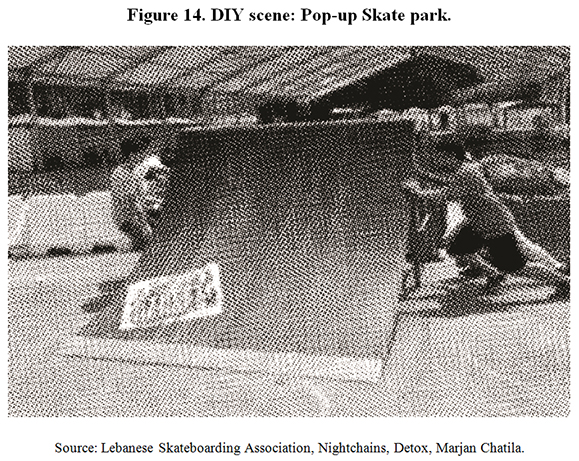
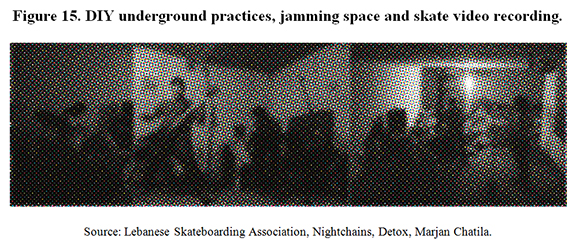
After the Pavillon Center venue closed in 2006, and the community inhabiting the streets again, renting American Dream pub exclusively for the scene was an attempt to strengthen the scene years later. The renovation of the place and gigs were to thrust the scene forward into revival.
The recordings of the albums or demos are frequently DIY (Satanic Overkill, 2009) or have been released by record labels (for example, Nightchains" self-released in 2005 Metal to the Bone, released afterwards in 2010 by Dead Master"s Beat German record label, and TAM89 split 7"" vinyl for Detox and Beirut Scum Society in 2012). The underground music scene having a joint audience between Heavy Metal and Punk, mosh, circle pits, and slam dance, govern the audience as compulsory anticipated rituals. (Figures 16, 17, 18 & 19)
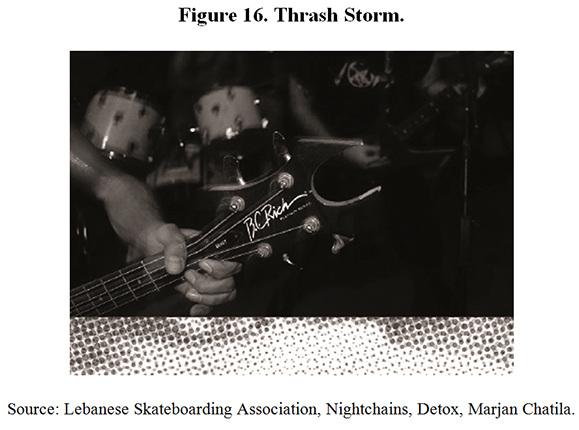
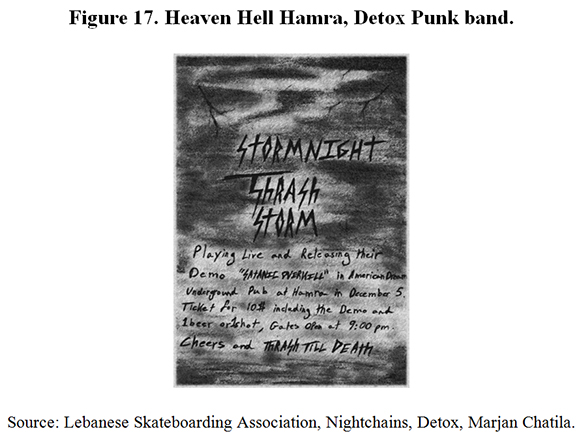
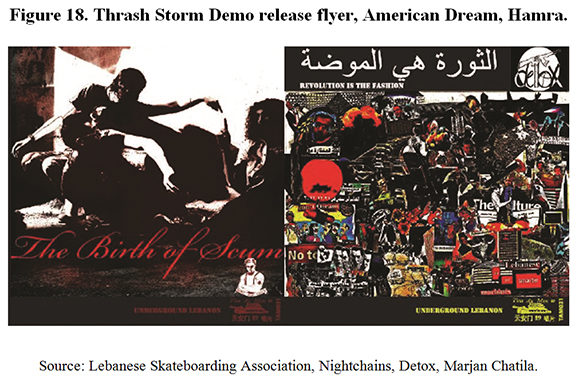
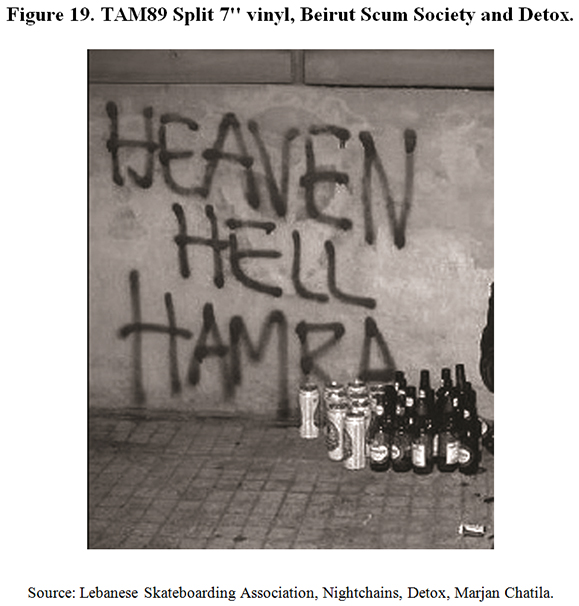
Detox"s The Alley resonates from the urban sphere, conjuring fragments of the blueprint.
The Alley (Detox) "We"re in the truth business"
"Walking on my hands with a heart in a can / Nothing has changed the memory remains the faces are still ugly/ Its complicated but we can talk it over in the Alley
No place to go I feel at home in the alley/ If you"re feelin bored or just need to take a piss the alley/ I draw on the walls cause ive got the balls and i hope it stays there/ I will drink the city stink in the alley
Nuclear War-Thrash Storm
Sounds of airplanes like thunder in the sky/ Roaming like eagles humanity is about to die/ Our time is short the overkill is near/ Creation of the bastards made us live in fear/ Striking of the bombs cracking the crust
Blasting the cannons direct stabs in the heart/ Screams of terror are now heard in hell/ High temperature of radiation will melt the shell
Nuclear war/ Total destruction left no place to hide"
From Thrash Storm lyrics are those that infer nihilism and an apocalyptic future referencing and embedded in the war. These following Nightchains lyrics position Metal as an alternate value to the system, unfolding another vision of hell as well, and deal with social issues such as corruption.
Over the Top-Nightchains
"Don"t need a law to protect me/ Ain"t no law that can stop me/ I am the master of the streets/ With the filthy and scum I deal
Heavy metal is the law."
Metal Storm-Nightchains
"I can"t believe I thought someday that I could clear my name/ The beasts saw it in my eyes the stare of a million kills/ As it stormed through the air killing from on high/ With a single note they brought up hell and crashed the heavens down
We"ll bring it unto thee/ Cracking to the sky/ Eyes of fear die this night/ Only Metal survives/ We"ll bring it unto thee/ Cracking to the sky/ Electric spears lead the hunt/ Everything beneath dies"
Where We Come From-Nightchains is anchored in the streets, in Hamra, and discharges war, corruption, and politics, to replace them with a Metal force as a displaced heritage, and alternate voice from the streets.
Its where we come from/ 16 years of war enough to say it all/ Its where we come from
Back on the streets a deal is a deal/ Suits me more than politics/ Fight for the pictures or fight for your fame/ be the baddest, six six six/ Alcohol and smoke whores and coke/ rejoice with the chorus, the bullets song/ What the hell is wrong? Corruption support !/ Time to burn it all down
Its where we come from/ 16 years of war and we"re ready for more/ Its where we come from
Hamra street going down/ Bullets in the air glass on the ground/ Watch the world passing by/ Watch our world standing by
The hybrid underground soundscape, from Punk rock, to Heavy Metal and Thrash, draws a sonic map. It recalls the war"s ghosts, or calls for a symbolic destruction and claiming territory, or summons the imaginary, setting new laws, Metal laws, or displacing the raw Punk energy into a non-place, liminal and charged with identity. It reflects the rooted urban experience of the sphere, bearing also the violence of the city, being driven by it, or destroying it through a counter-energy.
The body, inscribed in rituals within the urban music underground, in music practices as audience or as acts, or through thrashing the streets, is in a lateral contact with the city while it cuts through its surface; could it be by literally opening up and bleeding, contaminated by the ground, or in breaching a suspended space where the energy flows through alternating boundaries, and starts to write an unspoken narrative, through the surface that is visible, the body, or through the voice and sonic map.
The voices of the sphere alternate at a rhythm dependant on the visibility of the act, and on its "vocality".
Those songs elusive to the city tackle different issues, in Punk and Metal music respectively, along the political, social, cultural urban layers. The subversive voice suspended between its absence and anti-establishment presence to the participating co-listeners, is a rupture to the void stitched by the safety pin. They are born and stopped from the moment; invoke more uncompromising territory through hailing, elapsing and shortening the distance to the urban space, thus summoning power, where the voice can be located and starts to delineate boundaries.
Those songs elusive to the city tackle different issues, in Punk and Metal music respectively, along the political, social, cultural urban layers. The subversive voice suspended between its absence and anti-establishment presence to the participating co-listeners, is a rupture to the void stitched by the safety pin. They are born and stopped from the moment; invoke more uncompromising territory through hailing, elapsing and shortening the distance to the urban space, thus summoning power, where the voice can be located and starts to delineate boundaries.
The cusp moments, such as a gig, dilates the underground space, the capsule of voices, a social event immune to demise, the visible filling the gap or the lack of occurrence through duration. The vocal gesture is violent and errant, yet "irreversible" (Glissant, 1997). (Figures 20 & 21)
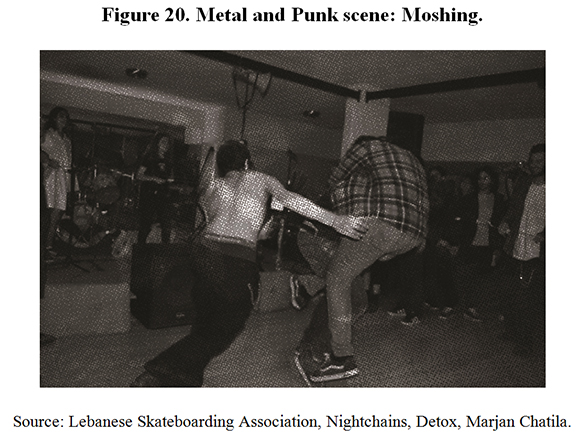
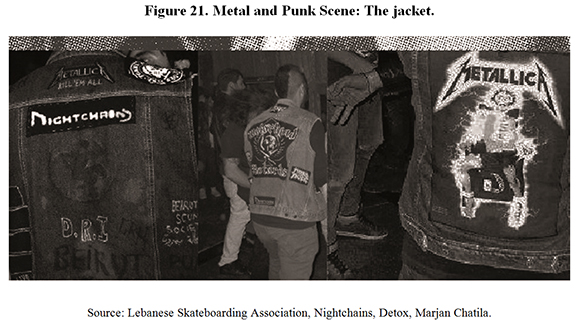
An Unspoken Narrative
The sonic and gestural forms are bound by their drive, and remap the city. Through skateboarding, the body wandering away while being there, encounters the urban space by unsettling it, breaking the rhythms of the city, resisting thus sociological objectification by constant elusiveness, and ritual resistance.
But the rhythm lead the narrative to become verbally linear, in a liminal time for questions that surfaced; the scene having a differentiated genesis, a constant shifting towards the urban axis, with punctual cuts through the layers of preexisting identity constructs, overridden by raw energy, while confronting the alternative music scene in Lebanon, the mainstream spaces with their marginalization and fetishism of the "Other". Nostalgia, survival, struggles, hopelessness and revival have been into question. The history of the community, DIY recordings, demos or digital releases, "Third World" record labels, emigration, the closed venues, the search for new venues, disbanding, building underground venues, economical obstacles, displacement, or the intrinsic shifting of group ties, longing to the return to the nucleus of the scene, the physical injuries, and the clashes with the securities, have shifted constantly the boundaries of the sphere. The scene witnesses its faculty to resist, appropriate, customize, borrow, preserve, and sustain itself, than sustaining the urban is surrendering: every act holds then an anachronic question. (Figure 22)
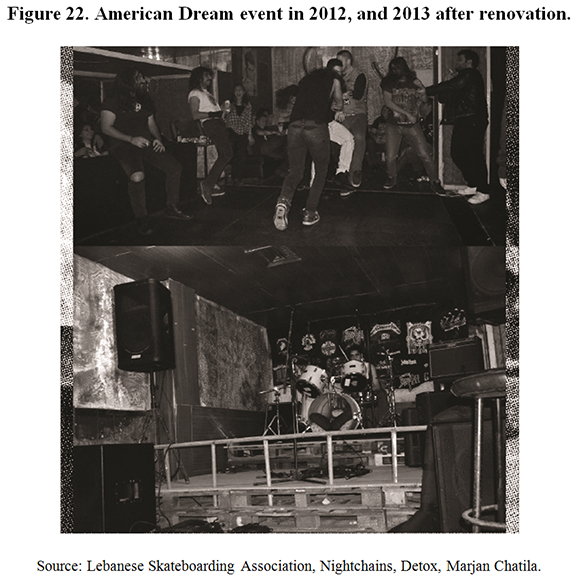
New horizons are being drawn, catalysts of changes restructuring the scene. If that force that once bound the scene remained in the past, one ought to look elsewhere? New projects were shaped, had digital releases. More ventures, rituals and DIY solid practices pushed the scene forward. In parallel, the surf scene started among skateboarders, and the construction of a surfboard. A DIY space was launched as well, for visual arts and zines (Artscape Beirut).
Those questions relate to the wider context of the research, suggest that the nucleus sphere -bearing so-called "Western" influences and references, yet having rooted geo-specific practices while transmitting a "displaced" musical heritage- raises issues about the legacy of DIY attitude and raw energy. The viability of the scene is anchored in its own history, having become an auto-referential non-place. Is thus the scene holding seeds or residues?
Being permeable to the global mainstream with digital visibility, World or European record labels and a virtual presence, while resisting the postmodern aesthetics" model of assimilating the ephemeral "Other", the community escapes models of representation and sociological objectification, accepting no discourse; resists constructs, even that of "subculture", but, discontinuously becomes a carrier of social actors. Are we bound then to ask if every act of production of space and music has become a fulfilled or broken promise for itself and for its reception, yet a viable and valuable mode to revitalize the study of social frameworks, how to evade sociological objectification for such a group that disrupts sociological frameworks?
If Lucifer leaves, does one keep on pushing?
Play a Fucking Instrument-Detox
Stop being so miserable
try to be useful
people change and I need someone on the bass and drums
learn a fucking instrument
have you really helped?
stop complaining about the scene
drinking beer on the street
play a fucking instrument!
you're going to get depressed one day
and you'll never be back anyway
but i need you now just to play like a machine gun
out of my way
have you really helped you parasites
I'm sick of waiting here
like a bean waiting to sprout
play a fucking instrument!
Enough-Detox
I can't be in the city no more
any minute now the locals will explode
( ) Maybe you think you want to be free
Maybe you believe in Anarchy
but everything you drank from reality
will always make you Society's baby
( ) Punk is dead, Anarchy's a lie
people want a system a piece of the pie
death to the people power
to me
yes i need to be safe from my own species
solitude is better than society
Empty community I need nobody
I need to be safe from my own species
Punk is dead, Anarchy's a lie
people want a system a piece of the pie
death to the people
power to me
yes i need to be safe from my own species
I Had A Dream. Fuck the Scene-Detox
the fucking dream to build a scene
Alzheimer"s is the disease
It seems to be they have forgotten who is me
you've changed and you will change
but the dream stays the same
people don't remember how good i was to them
Anything that"s good has to be deformed and forgotten
by the local snake who writes my history
In vain, my time was wasted on them.
If you want something done do it yourself
backstabbing scene of cover bands
It seems the cowards have ganged as one
Oppressive is the key
Offensive is the way
you've had too much to say
my seclusion from the everyday shit of society
of putting yourself out there on the street unproductively
to create you must destroy
that ticking bomb inside your head
fuck the scene
RUN PUNKY RUN
REFERENCES
Augé, M. (1992), Non-lieux, Paris: Seuil. [ Links ]
Bachelard, G. (1957), La poétique de l"espace, Paris: PUF. [ Links ]
Butler, J. (1997), Excitable Speech: A Politics of the Performative, New York: Routledge. [ Links ]
Burkhalter, T. (2013), Local Music Scenes and Globalization: Transnational Platforms in Beirut, New York: Thomas Routeledge Studies In Ethnomusicology. [ Links ]
Butz, K. (2011), Skate Punk, The Californian Safety Pin. Excerpts from a Journey to the Origins of Skate Punk, Huck Magazine (online), available at: http://www.huckmagazine.com/perspectives/reportage-2/skate-punk/ [ Links ]
Cohen, S. (1999), Scenes, in B. Horner, T. Swiss (eds.), Key terms in Popular Music & Culture, pp. 239-250. [ Links ]
Dardel, É. (1990), L"homme et la terre, Paris: Éditions du CTHS. [ Links ]
Docherty, T. (1996), Alterities: Criticism, History, Representation, Oxford: Oxford University Press. [ Links ]
Debarbieux, B. (1996), Le lieu, fragment et symbole du territoire , Espaces et sociétés, pp. 82-83, 13-36.
Di Méo, G. (1998), Géographie sociale et territoires, Paris: Nathan. [ Links ]
Dolar, M. (2006), A Voice and Nothing More, Massachussetts: MIT Press. [ Links ]
Glissant, É. (1997), Traité du tout-monde-Poétique IV, Paris: Gallimard [ Links ]
Hall, S. (1992), The Question of Cultural Identity, S. Hall et al. (eds.), Modernity and its Futures, Cambridge, pp. 273-326. [ Links ]
Hecker, P. (2005), Taking a Trip to the Middle Eastern Metal Scene: Transnational Social spaces and Identity Formation on a Non-national Level, Nord-Süd Aktuell (19), pp. 57-66. [ Links ]
Heidegger, M. (1958), Bâtir habiter penser, in Essais et Conférences, Paris: Gallimard. [ Links ]
Ihde, D. (1976), Listening and Voice: A Phenomenology of Sound, Athens: Ohio University Press. [ Links ]
Jankelevitch, V. (2003), Music and the Ineffable, New Jersey: Princeton University Press. [ Links ]
Nancy, J-L. (2007), Listening, New York: Fordham University Press. [ Links ]
Pries, L. (2001), The Approach of Transnational Social Spaces. Responding to New Configurations of the Social and the Spatial, in L. Pries (ed.), New Transnational Social Spaces, London and New York, pp. 3-33. [ Links ]
Tuan, Y-F. (1974), Space and Place: Humanistic Perspective, in Progress in Geography, pp. 211-252. [ Links ]
Virilio, P., Lotringer, S. (2008), Pure War, Los Angeles: Semiotext(e).
Weinstein, D. (1991;2000), Heavy Metal. The Music and its Culture, Da Capo Press. [ Links ]
Additional online sources:
Fungal Punk Nature
http://www.fungalpunknature.co.uk/FUNGALPUNK/CDReviews/Page%2078.html
Metal Archives
http://www.metal-archives.com/bands/Thrash_Storm/3540306073
http://www.metal-archives.com/bands/Nightchains/40856
http://www.metal-archives.com/albums/Thrash_Storm/Satanic_Overkill/275453
Maximum Rock n" Roll
http://maximumrocknroll.com/records-of-the-week-tam89-3/
Skateboard MSM
http://skateboardmsm.mpora.de/news/skateboarding-in-beirut-ein-reisebericht-aus-dem-libanon.html
Profane Existence
https://www.youtube.com/user/detoxlb https://www.facebook.com/detoxband Nightchains
https://www.facebook.com/pages/Nightchains/
Thrash Storm
https://www.youtube.com/user/Thrash6Storm














